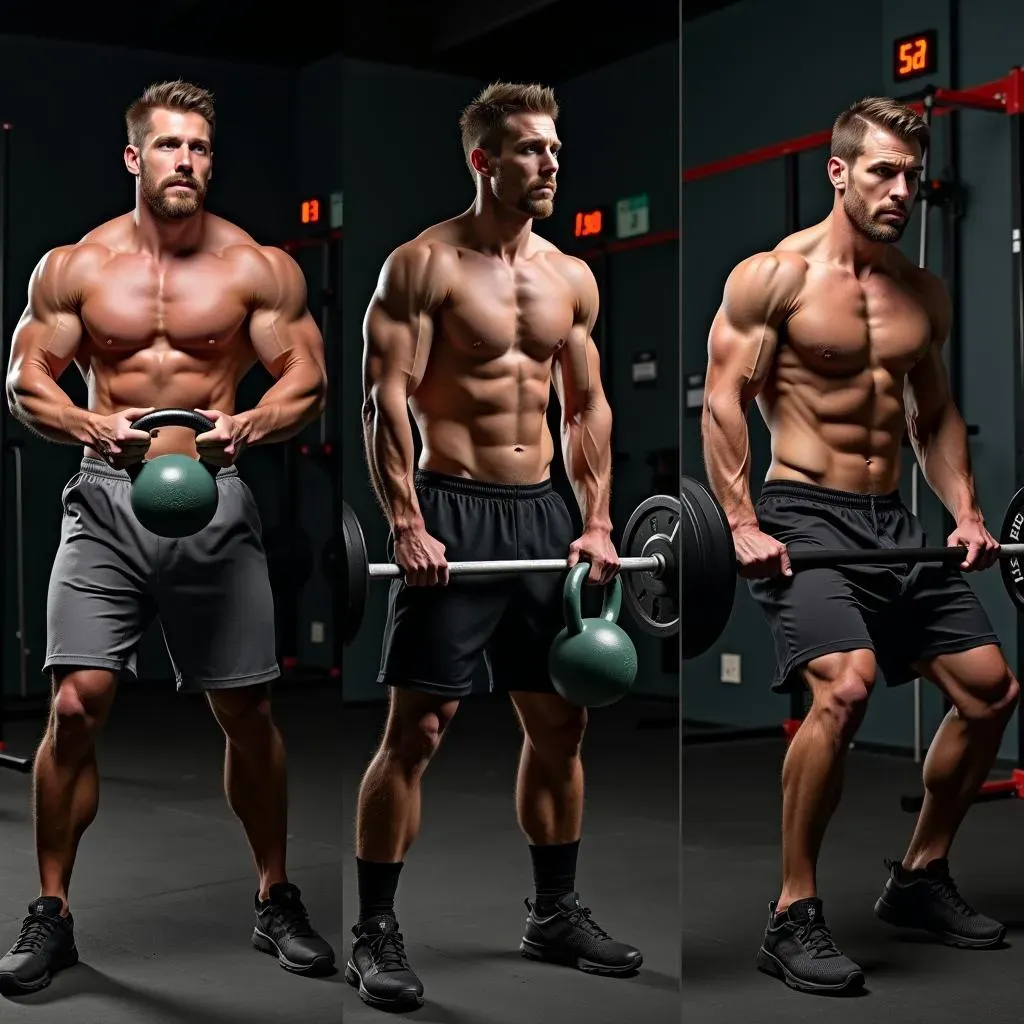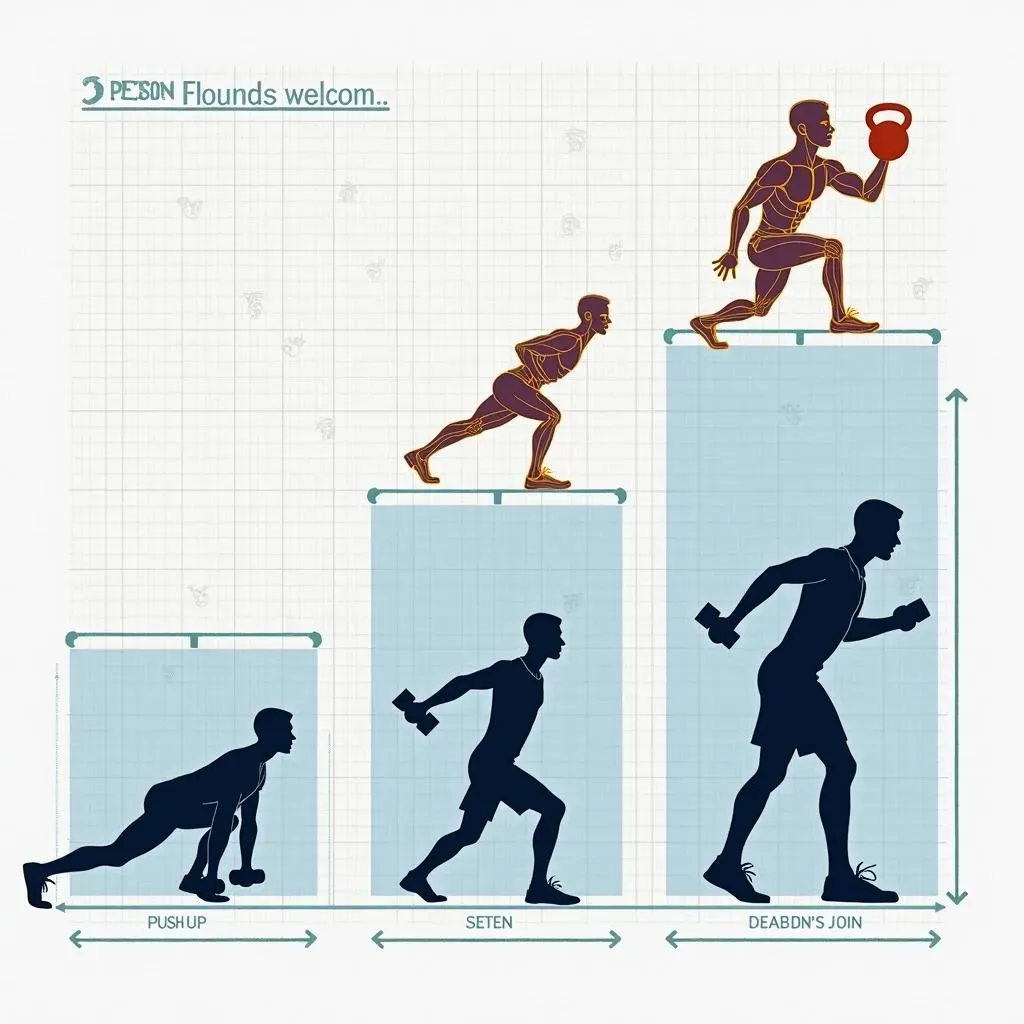Table of Contents
Ever feel like your overhead press is stuck in neutral? Like you're missing that raw, brute strength to push past plateaus? Enter the double kettlebell Z press, a seated overhead press variation that's about to become your new best friend (or worst enemy, depending on your perspective). Invented by the legendary Zydrunas Savickas (aka "Big Z"), this exercise is not for the faint of heart. It demands strict form, unwavering core stability, and a serious dose of mental toughness. We're talking about sitting on the floor, legs straight out, and pressing two kettlebells overhead without any help from your lower body.
How to Master the Double Kettlebell Z Press

How to Master the Double Kettlebell Z Press
The Setup: Foundation for Success
Alright, let's get down to brass tacks. The double kettlebell Z press isn't just about heaving weight overhead; it's about control, stability, and a whole lotta core engagement. First things first: the setup. You're going to want to find a spot on the floor where you can sit with your legs extended straight out in front of you. Now, if you're tighter than a drum, you might need to elevate your hips slightly by sitting on a yoga block or a folded towel. The goal is to maintain a relatively upright torso without rounding your lower back excessively.
Next, the kettlebells. Clean those bad boys up into the front rack position. That means the kettlebells should be resting comfortably on your forearms, close to your chest, with your elbows tucked in. Squeeze your armpits like you're trying to hold a stack of dollar bills – this will help activate your lats and create a stable base. Take a deep breath, brace your core like you're about to take a punch, and get ready to press. Remember, this isn't a race; it's a controlled, deliberate movement.
The Press: Up and Over (Without Cheating)
you're set up, you're braced, and you're ready to press. Now comes the fun part (or the agonizing part, depending on how you look at it). Initiate the press by driving the kettlebells straight overhead. Focus on keeping your wrists straight and your elbows locked out at the top. The key here is to avoid leaning back excessively or flaring your rib cage. Think about maintaining a straight line from your ears to your hips throughout the entire movement.
As you press, actively engage your core to prevent any unwanted movement or rotation. Imagine you're pressing against a wall – that's the kind of stability you're aiming for. Lower the kettlebells back down to the front rack position with the same level of control. Resist the urge to let them crash down – each rep should be smooth and deliberate. Rinse and repeat, focusing on maintaining perfect form throughout the entire set. If you start to lose your form, it's better to stop and rest than to grind out sloppy reps.
Key Element | Description |
|---|---|
Leg Position | Straight, but slight knee bend if needed for comfort. |
Core Engagement | Brace hard as if expecting a punch. |
Pressing Path | Straight up, avoiding excessive lean. |
Double Kettlebell Z Press: Sets, Reps, and Programming

Double Kettlebell Z Press: Sets, Reps, and Programming
Finding Your Starting Point
Alright, you've got the form down (or at least you're working on it). Now, how do you actually program the double kettlebell Z press into your routine? The answer, as always, depends on your goals. Are you trying to build strength? Muscle? Improve your overhead pressing technique? All of the above? Let's break it down. First, a reality check: the Z press is incredibly taxing. Don't expect to be throwing around massive weight right off the bat. Start light, focus on perfect form, and gradually increase the load as you get stronger.
Consider your current overhead pressing strength. Can you comfortably strict press a decent amount of weight? If so, you can probably start with a moderate kettlebell weight for the Z press. If you're relatively new to overhead pressing, or if you have any shoulder issues, start with lighter kettlebells. Remember, it's always better to err on the side of caution, especially when you're dealing with a challenging exercise like the Z press. Think of it as building a solid foundation – you can always add more weight later.
Sets and Reps for Different Goals
So, you know where to start, but what about the actual sets and reps? Here's a general guideline based on your training goals:
- Technique and Muscle Mass: 3-4 sets of 8-12 reps. Focus on controlled movements and feeling the muscles work.
- Strength: 3-5 sets of 3-5 reps. Use a heavier weight that challenges you while still maintaining good form.
- Endurance: 2-3 sets of 15-20 reps. Use a lighter weight and focus on maintaining consistent form throughout the set.
These are just suggestions, of course. Feel free to adjust the sets and reps based on your individual needs and preferences. The most important thing is to listen to your body and avoid pushing yourself too hard, especially when you're first starting out. The Z press is a marathon, not a sprint. Be patient, be consistent, and you'll see results over time.
Programming Considerations
Now, let's talk about where the double kettlebell Z press fits into your overall training program. Because it's such a demanding exercise, it's best to program it early in your workout, when you're fresh. Avoid doing it after a bunch of other heavy pressing exercises, as your form will likely suffer. It can be effectively paired with other core exercises, like planks or dead bugs, to further enhance core stability. Also, consider your overall training volume. If you're already doing a lot of overhead pressing, you might need to reduce the volume of your other pressing exercises to avoid overtraining.
Finally, don't be afraid to experiment. The Z press is a versatile exercise that can be adapted to suit a variety of training goals. Try different set and rep schemes, different kettlebell weights, and different variations to find what works best for you. The most important thing is to have fun and challenge yourself. With consistent effort and smart programming, the Z press can be a valuable tool for building strength, improving overhead pressing technique, and developing a rock-solid core.
Programming Tip | Description |
|---|---|
Placement in Workout | Early, when fresh. |
Pairing | Core exercises like planks. |
Volume | Adjust other pressing exercises to avoid overtraining. |
Avoiding Pitfalls: Common Double Kettlebell Z Press Mistakes

Avoiding Pitfalls: Common Double Kettlebell Z Press Mistakes
Leaning Back Excessively
Alright, let's talk about some common double kettlebell Z press blunders. First up: the dreaded lean back. I get it, pressing weight overhead from a seated position is tough. It's tempting to lean back to create more space and generate some momentum. But trust me, this is a recipe for disaster. Not only does it compromise your form and reduce the effectiveness of the exercise, but it also puts unnecessary stress on your lower back. Think about maintaining a straight line from your ears to your hips throughout the entire movement. If you find yourself leaning back excessively, it's a sign that the weight is too heavy, or that your core isn't engaged enough. Drop the weight and focus on tightening your core and maintaining a more upright posture.
Imagine you're pressing in a narrow hallway – you wouldn't want to bang your head on the wall behind you, right? That's the kind of mental image you should have in your head. Keep your torso as vertical as possible, and let your upper body do the work. Another common mistake is flaring the rib cage. This often goes hand-in-hand with leaning back, as it's another way to create more space and generate momentum. But again, it compromises your form and reduces the effectiveness of the exercise. Focus on keeping your rib cage tucked down and your core engaged throughout the entire movement. Think about drawing your ribs towards your hips – this will help activate your abdominal muscles and create a more stable base.
Failing to Engage the Core
Another big no-no is failing to properly engage the core. The double kettlebell Z press is as much a core exercise as it is a shoulder exercise. If you're not actively engaging your core, you're leaving a lot of potential gains on the table. Before you even start the press, take a deep breath and brace your core like you're about to take a punch. Think about tightening all the muscles around your midsection – your abs, your obliques, your lower back – as if you're creating a suit of armor around your spine. Maintain this level of core engagement throughout the entire movement. Don't let your core relax at any point during the set. If you find it difficult to maintain core engagement, try practicing some core-specific exercises, like planks or dead bugs, to strengthen your core muscles and improve your core awareness.
Also, be mindful of your breathing. Holding your breath can help create more stability, but it can also lead to increased blood pressure and dizziness. Try to find a breathing pattern that works for you – some people prefer to exhale as they press the weight overhead, while others prefer to exhale as they lower the weight back down. Experiment and see what feels best for you. The most important thing is to breathe consistently throughout the set, and to avoid holding your breath for extended periods of time. Remember, the Z press is a challenging exercise, but it's also a rewarding one. By avoiding these common mistakes and focusing on proper form, you'll be well on your way to mastering the Z press and reaping all of its benefits.
Mistake | Solution |
|---|---|
Leaning Back | Reduce weight, engage core, maintain upright posture. |
Flaring Ribs | Tuck ribs down, draw them towards hips. |
Core Disengagement | Brace core hard, practice core-specific exercises. |
Z Press Variations: Level Up Your Training

Z Press Variations: Level Up Your Training
Single Arm Z Press: The Anti-Rotation Challenge
Ready to crank up the intensity? The single arm Z press is where things get seriously spicy. By ditching the double kettlebell setup, you introduce a significant anti-rotation challenge. Your core has to work overtime to keep you from twisting and tipping over. This variation is fantastic for building unilateral strength, improving core stability, and ironing out any strength imbalances between your left and right sides.
To perform it, simply follow the same setup as the standard Z press, but hold a single kettlebell in the front rack position on one side. Brace your core extra hard, and press the kettlebell overhead, focusing on maintaining a straight, upright torso. Resist the urge to lean to the side or rotate your body. Lower the kettlebell back down with control, and repeat for the desired number of reps. Then, switch sides and repeat the process. Be prepared to use a lighter weight than you would for the double kettlebell version, as the single arm Z press is significantly more challenging.
Barbell Z Press: Old School Strength
If you're looking for a more traditional strength training approach, the barbell Z press is the way to go. This variation allows you to load up the weight and build serious pressing power. It's also a great option if you don't have access to kettlebells, or if you simply prefer the feel of a barbell. The setup is similar to the kettlebell version, but instead of holding kettlebells in the front rack position, you'll be holding a barbell across your upper chest. You can either clean the barbell into position, or have a spotter help you lift it into place.
From there, brace your core and press the barbell overhead, focusing on maintaining a straight, upright torso. As with the kettlebell version, avoid leaning back or flaring your rib cage. Lower the barbell back down with control, and repeat for the desired number of reps. The barbell Z press is a fantastic way to build overall pressing strength and muscle mass. Just be sure to start with a weight that you can handle with good form, and gradually increase the load as you get stronger.
Landmine Z Press: A Different Angle
Want to mix things up even further? The landmine Z press offers a unique twist on the classic Z press. By using a landmine setup, you change the angle of the press, which can help target different muscle fibers and improve your pressing mechanics. To perform the landmine Z press, you'll need a landmine attachment (or a corner of a wall) and a barbell. Insert one end of the barbell into the landmine attachment, and load the other end with weight plates. Sit on the floor with your legs extended in front of you, facing the landmine.
Grasp the end of the barbell with one hand, and position it in front of your shoulder. Brace your core and press the barbell up and forward, following the angle of the landmine. Focus on maintaining a straight, upright torso and avoiding any excessive rotation. Lower the barbell back down with control, and repeat for the desired number of reps. Then, switch sides and repeat the process. The landmine Z press is a great way to challenge your core stability, improve your pressing mechanics, and add some variety to your training.
Variation | Benefits |
|---|---|
Single Arm Z Press | Improved core stability, unilateral strength. |
Barbell Z Press | Increased pressing power, muscle mass. |
Landmine Z Press | Unique angle, improved pressing mechanics. |
Alternatives to the Z Press: Building a Strong Foundation

Alternatives to the Z Press: Building a Strong Foundation
Pike Push-Ups: Your Gateway to Overhead Strength
so maybe the double kettlebell Z press feels like trying to solve a Rubik's Cube while balancing on a tightrope. No sweat! There are plenty of other exercises that can help you build the necessary strength and stability to eventually tackle the Z press. Let's start with pike push-ups. These are like regular push-ups, but with your hips elevated, forming an inverted V shape with your body. This shifts the emphasis to your shoulders and upper chest, mimicking the pressing motion of the Z press.
Pike push-ups are a fantastic way to build shoulder strength and stability without requiring a ton of weight or equipment. They're also a great way to improve your body awareness and control. If you're new to pike push-ups, start with your hands closer to your feet to make the exercise easier. As you get stronger, gradually move your hands further away from your feet to increase the difficulty. You can also perform pike push-ups with your feet elevated on a box or bench to further challenge your shoulders.
Seated Dumbbell Press: Isolating the Upper Body
Next up, we have the seated dumbbell press. This exercise is a more direct alternative to the Z press, as it involves pressing weight overhead from a seated position. However, unlike the Z press, the seated dumbbell press allows you to use a bench for back support, which can make it easier to maintain good form and focus on the pressing motion.
To perform the seated dumbbell press, sit on a bench with your feet flat on the floor and your back supported. Hold a dumbbell in each hand, with your palms facing forward. Brace your core and press the dumbbells overhead, focusing on keeping your wrists straight and your elbows locked out at the top. Lower the dumbbells back down with control, and repeat for the desired number of reps. The seated dumbbell press is a great way to build overhead pressing strength and muscle mass, and it's a good option if you find the Z press too challenging or unstable.
Core Stability Drills: The Unsung Heroes
Last but not least, let's not forget about core stability drills. The double kettlebell Z press is as much a core exercise as it is a shoulder exercise, so it's essential to have a strong and stable core. Exercises like planks, dead bugs, and bird dogs can help you build the necessary core strength and stability to perform the Z press safely and effectively.
These exercises may not look as impressive as the Z press, but they're just as important. A strong core will not only improve your performance on the Z press, but it will also improve your overall strength, stability, and athleticism. So, don't neglect your core training – make it a regular part of your routine. By incorporating these alternatives into your training program, you'll be well on your way to building a strong foundation for the Z press and achieving your overhead pressing goals.
Alternative | Benefits |
|---|---|
Pike Push-Ups | Shoulder strength, body awareness. |
Seated Dumbbell Press | Overhead pressing strength, muscle mass. |
Core Stability Drills | Core strength, stability, overall athleticism. |
Press from A to Z
The double kettlebell Z press is more than just a challenging exercise; it's a tool for building serious strength, stability, and mental fortitude. By mastering this movement, you'll not only improve your overhead pressing power but also forge a stronger connection between your upper and lower body. So, ditch the excuses, grab your kettlebells, and get ready to embrace the burn. Your shoulders (and your ego) will thank you for it.